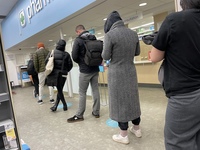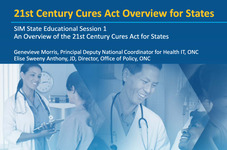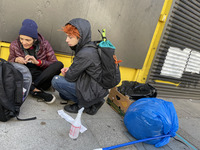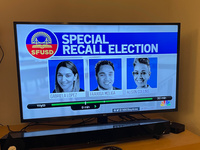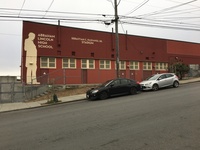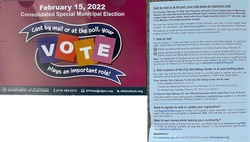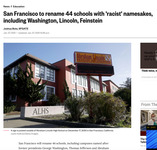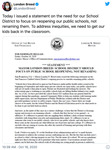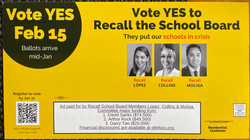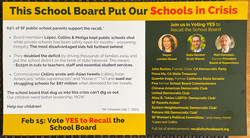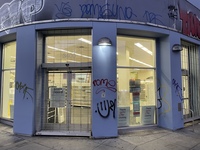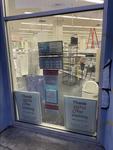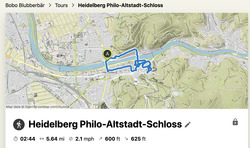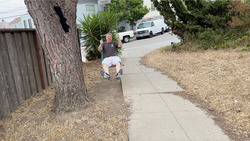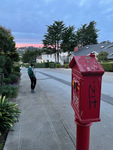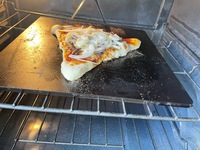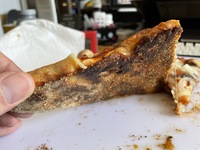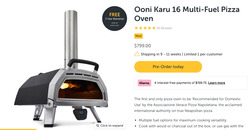 |
| Angelika/Mike Schilli |
|
|
Angelika The hope for a Christmas without COVID-19 in San Francisco has unfortunately not come true. Although the number of new infections is still relatively low, it is steadily increasing in San Francisco due to the Omicron variant. Currently, we have an average of 11 new cases per 100,000 residents in the city. Since the willingness to get vaccinated in San Francisco and the surrounding area is very high, many people are also getting the booster shot. It is now available for all age groups in the USA from the age of 16.
The responsible American health authority, the CDC (Centers for Disease Control and Prevention), recommends a 6-month interval for the Biontech/Pfizer and Moderna vaccines between the completion of the initial two-dose vaccination and the booster. Michael and I have both already received our booster shots. We simply booked an appointment at the drugstore chain "Walgreens" and, just like that, got the third shot in the arm. The whole process went relatively smoothly. We each made an appointment through the Walgreens website. For this, we only had to provide our name, address, and date of birth.
It was also asked when we received the first and second vaccination and with which vaccine. Then we could choose appointments. Although the CDC allows mixing vaccines, the Walgreens website only offered appointments with the same vaccine. That was fine with us. I went to the Walgreens around the corner from us, as they had Pfizer/Biontech. Michael had to go a bit further to the Walgreens in the Castro district. Before the vaccination, we had to fill out a form that asked about allergies and current Covid symptoms, and finally required a signature.
Our health insurance, by the way, fully covers the vaccination. If you don't have health insurance, the vaccination is still free of charge. The booster vaccination was then recorded in our official white CCD vaccination card. The card is in paper format and resembles an index card. After the booster vaccination, we both had mild symptoms, similar to those after the second initial vaccination series. I felt weak and exhausted. Michael had a slight cough and a headache. However, the symptoms disappeared after a day. In San Francisco, by mid-December, 68% of those over 65 had received the booster, 50% of those aged 50-64, 44% of those aged 35-49, and 29% of those aged 16-34 (Official Statistics ).
Even at our school, the vaccination of children is progressing diligently. Almost everyone is already fully vaccinated. My students were very happy that it was finally their turn. I really hope for their sake that there won't be new restrictions again because of Omicron.
Angelika Recently, I had a routine check-up with my gynecologist and was quite surprised when I could read her notes from our conversation online on the patient portal afterwards. At first, I thought she might have pressed the wrong button, because normally I didn't have access to these notes. Usually, I can only view prescriptions, lab reports, etc. through the portal, or contact my doctor via email or make appointments.
I didn't think much about it and forgot the whole thing until a few weeks ago when I was at the eye doctor, who then sent me a link so I could register on his very own patient portal to view his notes about my visit. Hmm, I thought to myself, this must be a new law and asked around about it. And indeed, the new so-called "21st Century Cures Act," passed in 2018, contains a provision that prohibits doctors from withholding electronically recorded notes from the patient.
Since nowadays almost every doctor types their conversation notes directly into a computer or tablet, these notes must now also be made available to the patient since April of this year. I find this commendable because, after all, it concerns the patient. I wonder how many doctors are now more mindful of their choice of words. There are already suggestions on the internet on how to phrase certain things more neutrally rather than judgmentally. A common expression among medical professionals, according to relevant forums, is "Poor Historian" when a patient cannot remember details about their health. The alternative suggestion is: "Cannot recall." Although "Poor Historian" is much funnier.
Michael As newsletter readers, you know that San Francisco has recently been struggling to get a grip on its skyrocketing crime rate. No one with a modicum of sanity doubts that the astronomical increase in car and home burglaries in San Francisco is due to the fact that perpetrators know they will go unpunished. District Attorney Boudin, who, following a completely broken political ideology, refuses to press charges even in cases with clear evidence, blames the police for allegedly not arresting enough thieves. However, the police blame Boudin, who immediately releases arrested criminals.
To make matters worse, Boudin brazenly claims in press conferences that the number of burglaries is declining, which is naturally because no citizen wastes their time sitting around at the police station to report a burglary. But when the upscale Louis Vuitton store in the city center was recently looted in broad daylight by an organized mob, videos of itwere circulating on Twitter and traditional news outlets.
As the news flashed around the world, Boudin was scared stiff. He promised on television to prosecute the looters, which actually happened in nine cases, but for the past four weeks, there has been dead silence in the press about what became of it. It is suspected that all the suspects are already back at large.
And no one who is clear-headed is surprised why San Francisco had more drug-related deaths than Covid deaths in 2020. There were 697 cases in San Franciscoof people who died of drug overdoses. 257 people died from Covid.
Why the high number of drug deaths? This is because in rundown neighborhoods like the Tenderloin, drug dealers can sell fentanyl, a cheap drug similar to crack with devastating effects, without facing any consequences thanks to our inactive district attorney.
Despite this devastating record, Boudin's followers still follow their guru like sheep and continue to double down, even though the game has long been lost. I regularly rub my eyes in astonishment when I look at the almost cult-like stubbornness of these followers, who spring up like mushrooms in online forums whenever someone says something against Boudin, and recite the party program as if brainwashed.
However, the overwhelmed Mayor London Breed recently had a complete meltdown on television, likely because elections are coming up in a little over a year, to point out the devastating conditions in the city, and announced that she would no longer tolerate them. She even used the actually forbidden word "bullshit" to categorize the events that (delicately under her leadership) had led to the complete breakdown of law and order in the city! Although she did not mention Boudin by name, she indicated that his political group could brace themselves for unpleasant measures.
To top it all off, she also declared a State of Emergency" in the Tenderloin district, probably to get government funding to increase police presence. And that, even though it has been less than six months since they were advocating to shrink the police budget with the then-popular slogan 'Defund the Police', to supposedly benefit black minorities with the proceeds. Imagine, now she wants more money from the state to turn back the clock! The right-wing press is laughing its head off.
AngelikaI wanted to add a bit more to what Michael wrote about the Tenderloin district, as I worked at the Tenderloin Childcare Center there for many years. The neighborhood has always had an exceptionally high crime rate in San Francisco and is notorious for drug deals, prostitution, and strip clubs. Since it is located right between City Hall and Union Square, the downtown shopping area, we have always advised visitors against taking a shortcut through the district. Even when I worked there many years ago, drugs were dealt openly on the streets, and mentally ill individuals would sometimes throw bottles at you. Shootings were also a daily occurrence.
With the children I worked with, we could only visit playgrounds that were fenced and staffed, like the Tenderloin Recreation Center on Ellis St., which is managed by the city. The other open playgrounds were overrun with drug dealers or needles. However, when we walked through the neighborhood with the children, there was still something like an honor code, and the drug addicts would quickly hide their needles when we passed by with the children.
The neighborhood has traditionally also had many immigrants who have just arrived in the US and often share a small one-room apartment with their entire family. The district also has a high concentration of buildings where single individuals can rent a single room. Many seniors without family connections and with low pensions therefore live in the Tenderloin district. We often had older volunteer helpers at the facility where I worked at the time, who enjoyed taking on the role of grandparents for the children. There are also many charitable and social organizations in the Tenderloin, such as "Glide Memorial" and "St. Anthony's.
The new drug "Fentanyl" now seems to be finishing off the neighborhood, much like the crack-cocaine crisis did in the 80s. Fentanyl is actually a powerful painkiller often used in pain management for cancer therapy, but it quickly leads to strong dependency. If overdosed, death occurs within a few minutes, whereas the window for heroin overdose, for example, is 1-2 hours. In San Francisco, the strategy for a long time was to distribute clean needles and the antidote Naloxone, which helps in the case of a Fentanyl overdose. However, this has not alleviated the crisis, and the number of drug deaths in the Tenderloin continued to rise in 2021.
By now, many people living with their families in the Tenderloin have had enough. They recently marched to City Hall to speak with our mayor, London Breed, and to express their frustration. Even former drug addicts from the Tenderloin say they would never have gotten off the drug if they hadn't eventually been given the choice between rehab or prison. Many in the neighborhood would be satisfied if at least the drug dealers were held accountable.
Angelika It is evident that tensions are rising in San Francisco and that citizens are becoming increasingly frustrated, as seen by the growing number of initiated recall procedures from political offices. I have already reported on the recall procedure against District Attorney Chesa Boudin (Rundbrief 11/2021). Last week, a brochure landed in our mailbox informing us about the next recall in San Francisco: This time, 3 out of 7 "School Board members" are up. What exactly is a "School Board"? Even translating the expression into German is not so straightforward.
The translation "committee" of a public school district probably come closest to the concept. School policy in the US is very decentralized, even more so than in Germany. Although certain requirements of the federal government or the state must also be met in the US, the individual school districts with their associated school boards have extensive powers. For example, they are responsible for finances, such as how much is spent on what, the curriculum, hiring of staff, etc. In San Francisco, the school board consists of 7 members, each elected for 4 years. They make school policy for 130 schools with 54,452 students (as of October 2019). However, the number of enrolled students dropped significantly during the pandemic, which was also related to the school board's policies.
In principle, any adult residing in San Francisco can run for election. However, the school board often includes teachers or parents with school-age children. The election will take place on February 15. If I were allowed to vote, I would vote to remove all three members listed for recall. However, only guardians who have a child in a public school in San Francisco are eligible to vote. By the way, in San Francisco, parents who are not American citizens are also allowed to participate in the School Board election.
Why are so many parents in San Francisco so upset that they want to remove half of the School Board? Much of it has to do with the school closures due to COVID-19. Public schools in San Francisco were closed for almost a year, even when infection rates in the city had been very low for a long time. Meanwhile, all private schools in San Francisco had resumed in-person classes, as had public schools in neighboring cities. What finally caused the situation to boil over was that the School Board spent months dealing with the renaming of San Francisco schools but did not develop a plan to finally get the children out of remote learning. What happened? The members of the School Board had the brilliant idea to rename 44 schools in San Francisco because the individuals after whom the schools were named had not behaved impeccably and had blemishes on their records by today's standards.
Even schools that bore the names of highly revered individuals were affected: "Lincoln High," named after Abraham Lincoln, who abolished slavery, and "Dianne Feinstein Elementary School," named after the still-serving Democratic Senator from California, Dianne Feinstein. The reasoning was that Lincoln was partly responsible for the execution of 38 Dakota Indians in 1862. Feinstein allegedly, as Mayor of San Francisco in 1984, replaced a Confederate Flag that had been stolen from in front of City Hall. Today, the flag is considered to be a symbol of racism.
However, the School Board acted rather arbitrarily, as the "Cesar Chavez Elementary School" was not included on the list, even though Cesar Chavez was known for using not-so-friendly terms for illegal Mexicans. The School Board also faced quite a bit of ridicule on both local and national levels because it became known that some decisions were based on Wikipedia entries and no historians had been consulted. Promptly, there was backlash from the local press and even from intellectual national newspapers like the New York Times. When our mayor, London Breed, had a meltdown on Twitter and urged the School Board to finally focus on reopening the schools, as this particularly helps disadvantaged families, the School Board decided to put the renaming of the schools on hold for the time being.
The recall machinery, however, could no longer stop this. You might be wondering why only 3 of the 7 members have to fear for their positions. Four of the 7 members had not been in office for 6 months when the recall process was initiated, and therefore, according to recall rules, cannot yet be removed. The three in question are: Gabriela López, Alison Collins, and Faauuga Moliga. Alison Collins is a particularly controversial figure. A few years ago, she posted some extremely nasty tweets that attacked Asian fellow citizens in a very unpleasant way, and she was foolish enough not to delete them before taking office. As a result, she lost her vice-chair position on the board when some clever individuals dug up these old tweets, but she did not resign as demanded. She then pursued a completely absurd $87 million lawsuit against the school district. Although it was immediately dismissed and did not go to trial, the whole situation is truly unparalleled in its absurdity.
And now the state of California is also threatening to take over financial supervision of the school district's budget. The San Francisco school district has a deficit of over 125 million dollars and must now create a plan to address the shortfall if it wants to retain its decision-making authority over how the money is allocated.
And as if that weren't embarrassing enough, our mayor London Breed went a step further and announced that the city will take a stronger supervisory position and, among other things, withhold funds if the School Board does not focus on its primary mission of educating the city's students. They are the ones who get left behind in all this political theater.
Michael Drugstore chains like Walgreens or CVS have recently been complaining about skyrocketing losses due to shoplifting. The thieves know the law is on their side. Even store-employed security personnel are legally not allowed to stop them if thieves are caught. This has led to situations where vagrants or disheveled schoolchildren maraud through the stores with huge garbage bags, stuffing everything within reach into them and walking out unchallenged. Recently, we were at the Safeway supermarket on a Sunday afternoon and witnessed firsthand how some teenagers stuffed goods into their backpacks and made a run for it. This has become the norm. The goods are then hawked on street corners, like at the Mission/24th subway station in broad daylight. It's obvious that the items come from the nearest drugstore. And reportedly, even Amazon now has stolen goods up for sale!
Although stores are allowed to check customers' bags and request a receipt at the exit, customers are not legally required to comply. If a thief walks out with obviously stolen goods, store personnel are not allowed to stop them. Now you might be wondering why mega-supermarkets like Costco check receipts at the exit and no customer objects to it. This is simply because Costco is a membership-based supermarket where every customer pays an annual fee. If a customer refuses the check at the exit, the supermarket uses cameras to identify who it was and revokes their membership. This way, Costco stays legally on the safe side.
For the past few months, there has been police officers from the San Francisco Police Department (SFPD) stationed in front of practically every Walgreens. They are authorized to stop and arrest lawbreakers. However, in the long run, this becomes costly, and many fear that this will eventually lead to further closures of these branches. Recently, the CVS chain announced that by January 2022, they will close six of their branches in San Francisco. This, in turn, affects the elderly and poor people who have difficulty traveling to the branches in the suburbs to fill their prescriptions or meet their drugstore needs. And so the cycle continues: If we don't prevent poor souls from looting the drugstores, we deprive even poorer souls of access to the necessary infrastructure -- something to keep in mind for the next election.
Michael Since the onset of COVID, we have practically been going for an hour-long walk every day, exploring the lesser-known corners of the city. Finding a nice circular route in a densely populated city like San Francisco that offers wide views and runs far from heavy traffic, perhaps even includes a 300-foot high staircase within a posh neighborhood, or an unpaved path known only to the immediate neighbors, is not so easy. Let alone finding such a previously explored path exactly the same way on the next hike; often, it gets tricky at the points where you actually need to turn, and you end up on a suboptimal path.
Enough of that! With the Komoot phone app, I can plan new city walks on the built-in map, save them, and when we want to go for a hike, I just need to open the app and select one of the 50 saved routes, quickly drive to the starting point, and then get going. We have the craziest routes, one goes over rocks that you have to climb down, and another goes through the wing of an abandoned old hospital. All strictly secret, of course! And when we were in Germany last summer, as tourists sightseeing in the city of Heidelberg, I also created a circular route there that passed by all the sights, from the Philosopher's Walk to the castle.
When Komoot navigates through a previously saved hike, it informs you at which corners you need to turn right or left to follow the given route and find your way back to the parked car. The app itself is free, and the basic version is sufficient if you only stay in a specific region. However, if you leave your home area, it suddenly doesn't recognize any maps, even though they are based on the freely available OpenStreetMap data. But if you pay an additional 30 dollars, it suddenly works everywhere. Okay, the Komoot team needs to keep the lights on in the server room, and with your contribution, you're practically paying their electricity bill.
The clumsy English of the documentation, by the way, reveals that the app is a German product. Rumor has it that many British road cycling enthusiasts also use it for navigation. All in all, it is well-made, although very amateurishly monetized. But well, German internet entrepreneurs are not good at that. Tragically, they always leave money on the table. Okay, at least those who stayed behind in Germany, haha! As an outdoor product, however, I recommend the app without reservation.
Michael When it comes to pizza, like many of you, I grew up with the average offerings in Germany, which aren't bad. But when I was a young lad and visited New York City for the first time, driven by hunger in the middle of the night, I left the youth hostel and walked across the street to a branch of the chain "Roy's Pizza" to get a slice. I almost fainted because this piece of pizza was orders of magnitude better than anything I had ever devoured in Germany under the name "pizza".
In America, pizza naturally tastes much better than in its country of origin, Italy, where the dish is mainly fed to clueless budget tourists who can't afford meals in the more upscale restaurants with real Italian food. In America, and actually mainly in New York City, pizza ranks among the dishes where the locals have zero tolerance for sloppy cooking skills. The "New York Style" is known throughout the country for its thin, crispy crust, and when it comes to ingredients, apart from tomato sauce, mozzarella cheese, and maybe anchovies, nothing else is really allowed. Asking for anything different would be about as embarrassing as ordering red wine with ice in a street café in Paris.
In San Francisco's pizzerias, I often find the pizza to be too doughy. I don't even want to mention the "Chicago-Style," which for the worldly man is not pizza at all, but rather a quiche, though opinions on this differ. And another thing: frozen pizza is an imposition, and anyone who heats one up at home should consider whether they haven't already turned into a one-way street in life, at the end of which stands a sign reading "Bankruptcy." The soggy pizza from delivery services is no substitute either, and for those who want to eat pizza at home, the only real option is to knead the dough yourself, stretch it out, add canned pizza sauce (Don Peppino is quite good) and grated cheese (a bit of Parmesan first, then a heap of Mozzarella), and somehow bake it using your home oven.
To effectively transfer the heat from the home oven, which usually maxes out at 550°F (290°C), to the pizza, many people buy a so-called pizza stone. This is a ceramic slab that you heat in the oven for a good half hour before launching the flat pizza onto it using a large paddle. This method works quite well, but the stone does not transfer heat to the pizza as effectively as a piece of steel that is equally hot. Why? The thermal conductivity of steel is higher than that of ceramic. Consequently, an equally hot piece of steel transfers more heat to the pizza dough lying on it, causing the bottom to slightly burn. This results in dark brown spots on the underside, known as "leoparding," which gives the dough its distinctive pizza flavor. The problem, of course, is that a one-centimeter thick piece of steel in the size of 40cm x 40cm weighs about as much as a small car and starts to rust within seconds if left standing wet. Like a cast iron pan, you should not use dish soap to clean it; instead, you should occasionally apply a layer of cooking oil to prevent the dough from sticking during the next pizza baking session.
Admittedly, this dough doesn't taste like it was baked in a 500-degree wood-fired oven of a pizzeria, but for a home oven, the result is acceptable -— certainly much better than with conventional methods. If you still want to compete with a pizzeria at home, you can buy a portable gas or wood oven from the company "Ooni." Reliable sources have assured me that the pizzas from these small but hot devices actually have pizzeria quality. Unfortunately, we don't have the space, and such an oven has to be kept outside because of the exhaust fumes!
Greetings from San Francisco:
Angelika and Michael


